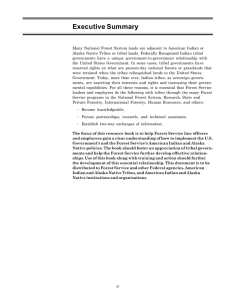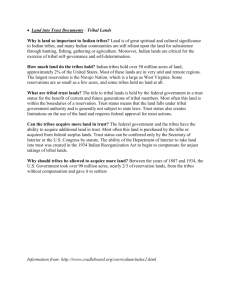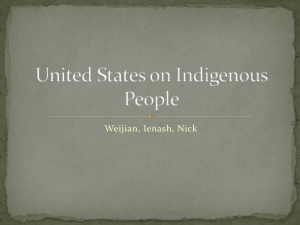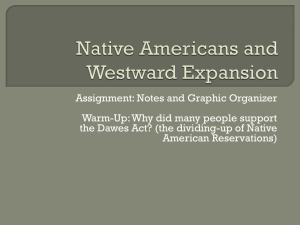Document 10593056
advertisement
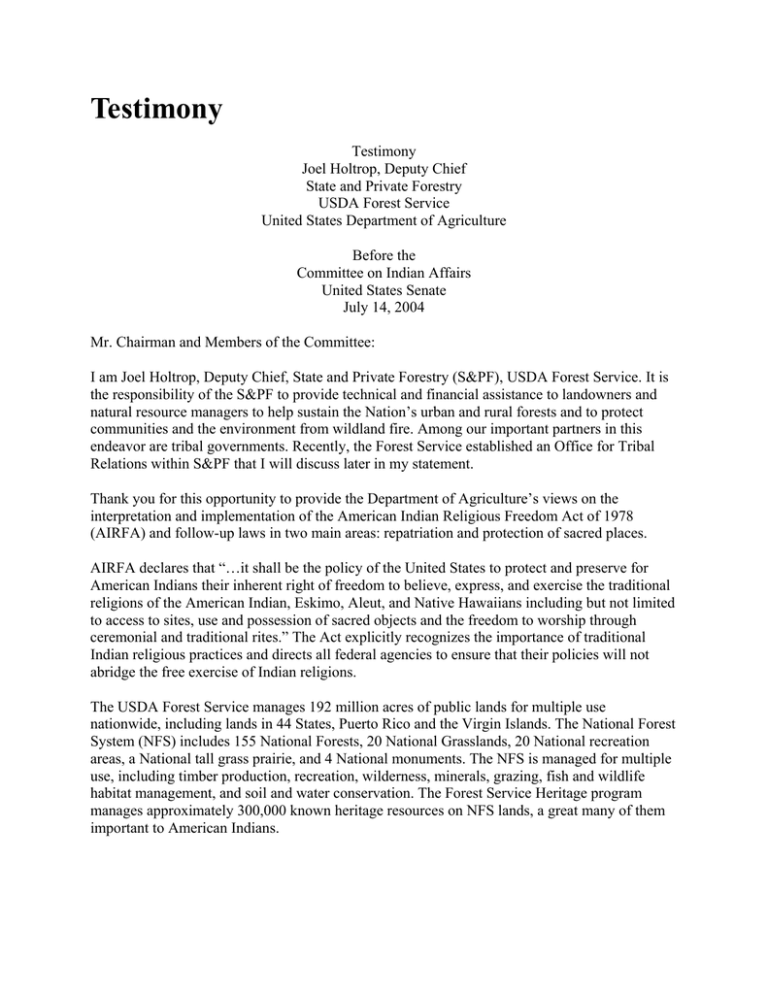
Testimony Testimony Joel Holtrop, Deputy Chief State and Private Forestry USDA Forest Service United States Department of Agriculture Before the Committee on Indian Affairs United States Senate July 14, 2004 Mr. Chairman and Members of the Committee: I am Joel Holtrop, Deputy Chief, State and Private Forestry (S&PF), USDA Forest Service. It is the responsibility of the S&PF to provide technical and financial assistance to landowners and natural resource managers to help sustain the Nation’s urban and rural forests and to protect communities and the environment from wildland fire. Among our important partners in this endeavor are tribal governments. Recently, the Forest Service established an Office for Tribal Relations within S&PF that I will discuss later in my statement. Thank you for this opportunity to provide the Department of Agriculture’s views on the interpretation and implementation of the American Indian Religious Freedom Act of 1978 (AIRFA) and follow-up laws in two main areas: repatriation and protection of sacred places. AIRFA declares that “…it shall be the policy of the United States to protect and preserve for American Indians their inherent right of freedom to believe, express, and exercise the traditional religions of the American Indian, Eskimo, Aleut, and Native Hawaiians including but not limited to access to sites, use and possession of sacred objects and the freedom to worship through ceremonial and traditional rites.” The Act explicitly recognizes the importance of traditional Indian religious practices and directs all federal agencies to ensure that their policies will not abridge the free exercise of Indian religions. The USDA Forest Service manages 192 million acres of public lands for multiple use nationwide, including lands in 44 States, Puerto Rico and the Virgin Islands. The National Forest System (NFS) includes 155 National Forests, 20 National Grasslands, 20 National recreation areas, a National tall grass prairie, and 4 National monuments. The NFS is managed for multiple use, including timber production, recreation, wilderness, minerals, grazing, fish and wildlife habitat management, and soil and water conservation. The Forest Service Heritage program manages approximately 300,000 known heritage resources on NFS lands, a great many of them important to American Indians. Because Tribes are affected by NFS land and resource management policies, programs and actions, the Forest Service must consult with Tribes on a government-to-government basis under various statutes, Executive Orders, and agency directives. Sacred Sites Under the 1982 planning regulations, the Forest Service is required to coordinate regional and forest planning efforts with Indian tribes, to notify tribes whose lands or treaty rights are expected to be affected by the agency’s activities, to review and consider the objectives of Indian tribes as expressed in their plans and policies, and where conflicts are identified, to consider alternatives so conflict may be resolved. Beyond the planning requirements, other existing laws ensure that American Indians have an opportunity to participate in land management decisions. The Forest Service National Environmental Policy Act (NEPA) procedures require the Forest Service to determine the scope of issues to be addressed in an environmental analysis. Under the National Historic Preservation Act, the Forest Service is required to identify historic properties on NFS lands. The process of determining the effects of management on these sites provides for consultation of interested parties, including Indian tribes. The Archaeological Resources Protection Act of 1979 prohibits the disturbance or destruction of archaeological resources, including Native American religious and cultural sites located on Federal lands except under a permit issued by the appropriate Federal land manager. The land manager must notify and consult with concerned Indian tribes regarding any permit that may harm an Indian religious artifact. As part of this program, the Forest Service attempts to identify all Indian tribes having aboriginal or historic ties to NFS lands and to determine the location and nature of the specific sites of religious or cultural importance for future reference for management decisions affecting the land. Executive Order 13007 directs Federal land management agencies, to the extent permitted by law, and not clearly inconsistent with essential agency functions, to accommodate access to and use of Indian sacred sites, to avoid affecting the physical integrity of such sites wherever possible, and, where appropriate, to maintain the confidentiality of sacred sites. Federal agencies are required to establish a process for ensuring that reasonable notice is provided to affected Tribes of proposed Federal actions or policies that may affect Indian sacred sites. Sacred sites are identified by Tribes. Recently, the Forest Service chartered a Task Force on Sacred Sites to develop policy and guidelines to specifically address EO 13007 and our other statutory and regulatory responsibilities to better protect the sacred sites that are entrusted to our care. The Task Force has been meeting with tribal governmental and spiritual leaders throughout Indian Country. Repatriation The Native American Graves Protection and Repatriation Act of 1990 (NAGPRA) addresses the protection of Native American burial sites and the repatriation of human remains, funerary objects, sacred objects, and objects of cultural patrimony. NAGPRA requires federal land management agencies to consult with Indian tribes prior to intentional excavations and requires notification in the event of inadvertent discovery of human remains or cultural items. NAGPRA also sets forth a process for the repatriation of human remains and cultural items in the possession of federal agencies and museums to the Indian tribe or lineal descendants to whom these remains or items belong. Across all Federal land management agencies, NAGPRA compliance is very emotional, highly sensitive and a high priority for Tribes. A related concern, but one not addressed in NAGPRA, involves reburial of human remains and cultural items on lands that Indian tribes used and occupied traditionally, which includes NFS lands. Reburials have been occurring on NFS lands in certain regions even though a consistent national policy did not exist until direction was provided in the Forest Service Manual in March 2004. For example, there have been formal regional FS policies in the southern and southwestern regions, developed in collaboration with Tribes. In addition, providing confidentiality of information related to reburial sites has been a primary concern of Indian tribes regarding reburial. In addition to cases of individual remains, the Forest Service and Tribes are working together in situations involving complex cultural affinities to identify disposition preferences for large collections of artifacts and remains. These will involve reburial at locations other than archaeological sites and thus entail a higher level of environmental analysis and documentation, and concern over the confidentiality of that documentation. Forest Service implementation and compliance with AIRFA and NAGPRA depends on maintaining effective consultation and collaboration with Tribal governments. Several years ago, the Forest Service’s National Leadership Team (NLT) concluded that the agency’s working relationship with many tribal governments needed significant improvement. The leadership commissioned a National Tribal Relations Program Task Force (Task Force) to address recurring issues that affected our work with Indian tribes. The finding and recommendations of the Task Force were published as the “Report of the National Tribal Relations Program Task Force: A Vision for the Future”. The report provided recommendations to improve the consistency and effectiveness of program delivery and to institutionalize long-term collaborative relationships with tribal governments. Based on the Task Force report, the Forest Service has taken action on several fronts, all of which should improve the agency’s collaborative relationships with Tribes and reduce conflicts with Tribes over a number of issues, including the protection of sacred sites and reburial. Office of Tribal Relations –The Forest Service established an Office of Tribal Relations to provide the infrastructure and support necessary to ensure high quality interactions across programs with Indian Tribes on a government-to-government basis. The office will integrate Tribal issues across Deputy Areas, advise the Chief on Tribal issues and concerns, and ensure that tribal government relations are a standard operating procedure for the agency. Directives – In March, the Forest Service issued new manual and handbook direction on tribal relations that provides clear guidance for agency tribal relationships, spelling out specific obligations of Forest Service officials and providing guidelines for conducting government-togovernment relations with tribes. Training – The agency has instituted core skills training pertaining to Forest Service policy with regard to tribal relations. The training also incorporates the need to protect sacred sites and other culturally important areas. All agency line officers and staff who regularly interact with Tribes will be required to demonstrate a core competency in tribal relations. Supplemental and specialized training for agency positions that involve interactions with tribal governments will also be developed. The agency has identified certain recommendations that cannot be fully implemented without legislation to create new or clarify existing authorities. The legislative proposal, which was included in the Administration’s Fiscal Year 2005 Budget would provide: authority for the Forest Service to close specific areas of NFS lands to the general public for the shortest duration of time necessary to accommodate various tribal uses, including traditional tribal use. authority to provide forest products free of charge to Indian Tribes for traditional and cultural purposes. express authority for reburials on NFS land. authority to maintain the confidentiality of reburial and other information. The legislative proposal is currently in clearance at the Department. Mr. Chairman, the religious freedom of American Indians is, and will continue to be, an important factor in our management of the National Forest System. The agency has made great strides under the leadership of Chief Dale Bosworth to increase awareness of all FS employees of the agency’s responsibilities to Indian tribes. The Forest Service is eager to work with Indian tribal governments. Together we can take appropriate actions to support the religious beliefs and practices of American Indians on NFS lands. I would be pleased to answer questions that members of the Committee may have.
